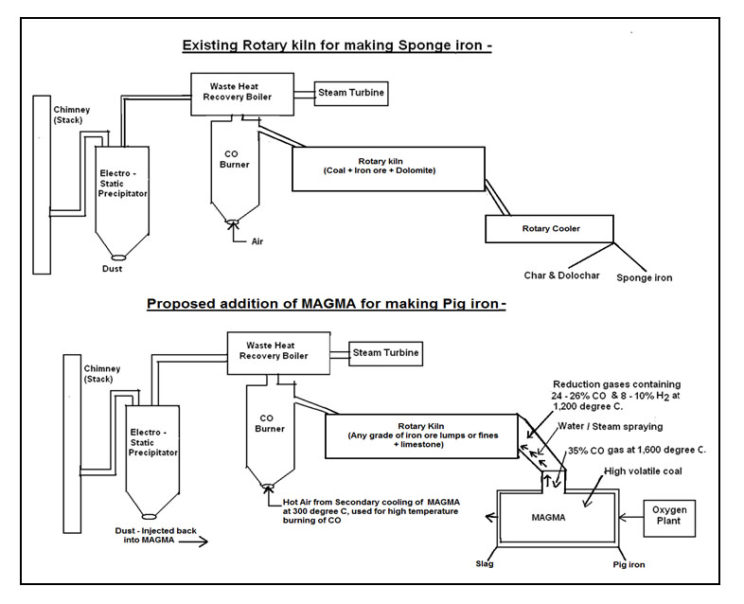Convert your sponge iron plant into a cast iron plant and also increase its capacity by 3-4 times, using the MAGMA smelting unit
The MAGMA technology from Russia can be used for the life-extension of your existing rotary kiln-based sponge iron plants, by converting them into cast iron plants.
MAGMA can replace the blast furnace technology for making pig iron. MAGMA can use iron ore fines & South African / Australian thermal coal to make pig iron & there is no need for iron ore lumps / sinter feed / pellets or coke. MAGMA is the improved ‘Romelt’ process & is offered by the Russian company ‘Technologia Metallov LLC’.

MAGMA produces pig iron from iron ore, by the method of liquid-phase reduction of iron. In the process, iron ore fines & limestone are pre-heated by the off-gases of the smelting chamber in a rotary kiln, to temperatures of 900-1,000°C & then hot-charged into the MAGMA chamber. Coal is directly burnt in oxygen inside MAGMA. The liquid-sodium cooling system adopted in MAGMA maintains the temperature of the body of the smelting chamber at around 500°C. This helps to reach very high temperatures of up to 1,900°C in the working space of the smelting chamber & up to 1,650°C in the molten slag zone. Under such conditions, a skull is formed in the working surface of the smelting chamber & this skull is used instead of conventional refractories.
After pre-heating the charge materials in the rotary kiln, heat from the off gases of MAGMA are sent to a boiler unit at 1,000-1,050°C for power generation, to meet the electricity requirements of the oxygen plant and other iron & steel making operations.
To convert the rotary kiln-based sponge iron plant into a pig iron plant, MAGMA smelter is installed in place of the rotary cooler, and all other existing infrastructures are utilized. A 100 TPD sponge iron plant can make 1,08,000 tons of pig iron per year; a 200 TPD plant can make 1,72,000 tons of pig iron per year and a 350 TPD plant can make 2,60,000 tons of pig iron per year, using MAGMA technology.
The cost of producing pig iron in MAGMA ranges from Rs.14,000 – Rs.15,000 per ton & the cost of producing steel by using a subsequent Converter (BOF) / Gas Oxygen Refiner (GOR) is Rs. 18,000 – Rs. 20,000 per ton, depending on the location. The incremental investment can be recovered in 2-3 years.
Schematic views of the existing rotary kiln for making sponge iron & the proposed addition of MAGMA for making pig iron are given below –

Advantages of converting a sponge iron plant into a pig iron plant are –
- Any grade of iron ore (55-63% Fe) and any size of iron ore and coal (3-20 mm) can be used in MAGMA. South African / Australian thermal coals are ideal, as their slag melt at lower temperatures. Since the coal is directly charged into MAGMA, there is no problem of kiln accretion & no frequent stoppage for maintenance. There is also no generation of char & dolochar.
- After using the primary heat of coal & oxygen for liquid-phase reduction of iron ore into iron, the secondary heat by way of off-gases come out of MAGMA at 1,600°. This gas is cooled in the outlet of MAGMA to 1,200°C by water jet spraying. In the gas cooling process, water-shift reaction takes place & the gas containing CO changes into gas containing CO and H2. In the presence of these reduction gases at high temperatures, partial de-carbonization of limestone & partial reduction of iron oxides take place. The heated charge is fed into the surface of MAGMA for smelting & for reduction of iron oxides into iron, in the liquid bath.
Off gases going out of the rotary kiln are burnt in the gas burning chamber to convert the residual CO into CO2, thus increasing the gas temperature for power generation. For burning this gas, a large quantity of heated air available at 300°C from the secondary cooling of MAGMA can also be used. Pollutants such as ESP dust, coal dust & iron ore dust are injected back into MAGMA, so that the sponge iron plant can meet the European norms for environmental protection.
- Since the space required for coal is saved in the rotary kiln & since the travelling time in the kiln is only 2-3 hours to pre-heat and to pre-reduce the iron ore, a 100 TPD rotary kiln can take 575 TPD of iron ore fines, 180 TPD of limestone and produce 360 TPD of pig iron (1,08,000 tons per year) in a medium-sized MAGMA unit.
At the time when the sponge iron units are becoming unviable due to high input cost & low output price; the availability of high grades of lumpy ore at reasonable prices is an unresolved issue; electricity supply from the state grid is either not available or not economical for steel making in the induction furnace route; steel quality requirement is increasing day-by-day and environmental concerns threaten the closure of sponge iron units, MAGMA provides a greater flexibility to use a wide range of raw materials; for life-extension of sponge iron units; to utilize the infrastructures already created and to ensure its long term viability.
